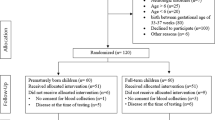Abstract
The prolidase activity in serum and in erythrocytes was measured in 28 healthy mothers and in the cord blood of their newborn babies in using a modified Chinard method. 45 healthy non-pregnant women aged between 15–36 years formed a control group. Biochemical parameters (CK, BUN, C-peptid, AFP, Uric acid) were also measured. The serum and erythrocyte prolidase activities in maternal blood were 45.8±13.4 U/L and 37.8±2.7 U/g Hb respectively. There was no significant difference in the enzyme activities between pregnant women and the control group (p>0.05). However serum and erythrocyte prolidase activity in cord blood (20.3±8.2 U/L and 31.6±7.3 U/g Hb) was significantly different when compared with control group (53.4± 14.7 U/L in serum and 42.3±10.3 U/g Hb in erythrocyte, p<0.001). There was a significant correlation between maternal and cord blood serum enzyme activity (r: 0.76 p<0.01). This correlation was also shown in erythrocyte prolidase activities of both groups (r: 0.49, p<0.05). Cord blood prolidase activity was positively correlated with birth weight (r: 0.89, p<0.01). Prolidase activity in cord blood was low even though collagen turnover is increased in fetal growth.
Similar content being viewed by others
Author information
Authors and Affiliations
Additional information
Received: 15 June 2000 / Accepted: 4 October 2000
Rights and permissions
About this article
Cite this article
Namiduru, E., Özdemir, Y., Kutlar, I. et al. A study of prolidase in mothers, their newborn babies and in non-pregnant controls. Arch Gynecol Obstet 265, 73–75 (2001). https://doi.org/10.1007/s004040000142
Issue Date:
DOI: https://doi.org/10.1007/s004040000142




